Battle of Kamenets-Podolsky in western Ukraine, March-April 1944. The exemplary breakout of the German 1st Panzer Army (General Hube) from the pocket according to the plan of Field Marshal Manstein.
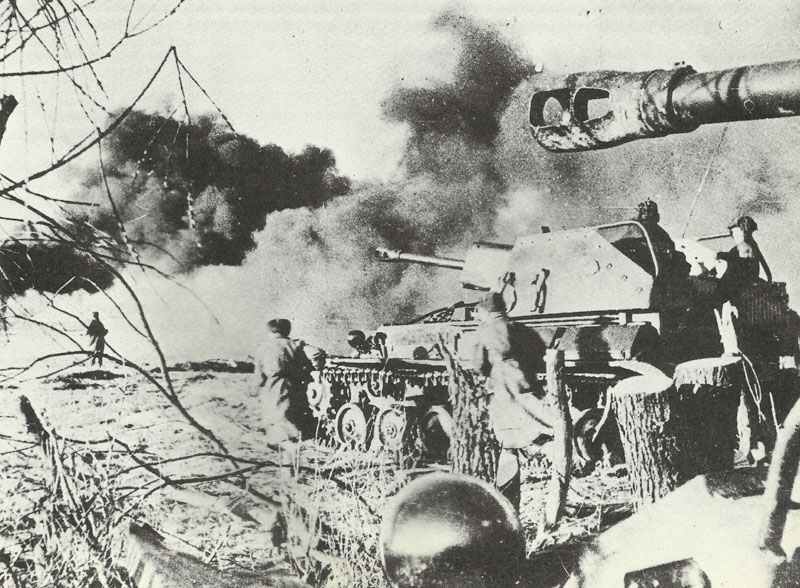
Battle of Kamenets–Podolsky 1944: An important Encounter in World War II
Table of Contents
The Battle of Kamenets–Podolsky, also known as the Hube Pocket, was a significant engagement that took place during World War II on the Eastern Front.
In December 1943, the Soviet Union launched the Proskurov-Chernovtsy Offensive with the goal of encircling the 1st Panzer Army of Army Group South, trapping German forces in the region of Kamenets-Podolsky, in what is now Ukraine.
The strategic town of Kamianets-Podilskyi, located within the Vinnytsia Oblast, became the focal point of this operation, marking one of the many grueling conflicts of the larger Soviet Dnieper-Carpathian Offensive.
By late March 1944, the Soviet forces had successfully encircled the German troops, creating a pocket near Kamenets-Podolsky.
German forces found themselves isolated from the main supply lines and subject to relentless Soviet assaults.
The battle underscored the shifting tides of the war as Soviet troops, advancing westward, began reclaiming territories that had been previously occupied by Axis forces.
The German army, known for its strategic prowess during much of World War II, faced dire circumstances as their encircled units fought to escape the pocket.
The battle exemplified both the tenacity and the desperation inherent in the conflict on the Eastern Front.
The ultimate resolution of the Battle of Kamenets–Podolsky provided a clear indication of the Soviet Union’s growing military capability and foreshadowed their continual push towards Germany and eventual victory in the war.
Historical Context
In early 1944, the Eastern Front of World War II was the stage for the strategic Battle of Kamenets-Podolsky, also known as the Hube Pocket. Encirclement and potential destruction of the German 1st Panzer Army highlighted the pressing stakes for both warring sides.
Strategic Importance of Kamenets-Podolsky
Kamenets-Podolsky, now located in Ukraine, was critical for the Germans during their invasion and occupation.
As a key transport and supply hub, it held significant strategic value. Control over the city would enable the Soviet Union to cut off the German forces from their main lines, disrupting their maneuvers and potentially leading to their isolation and surrender.
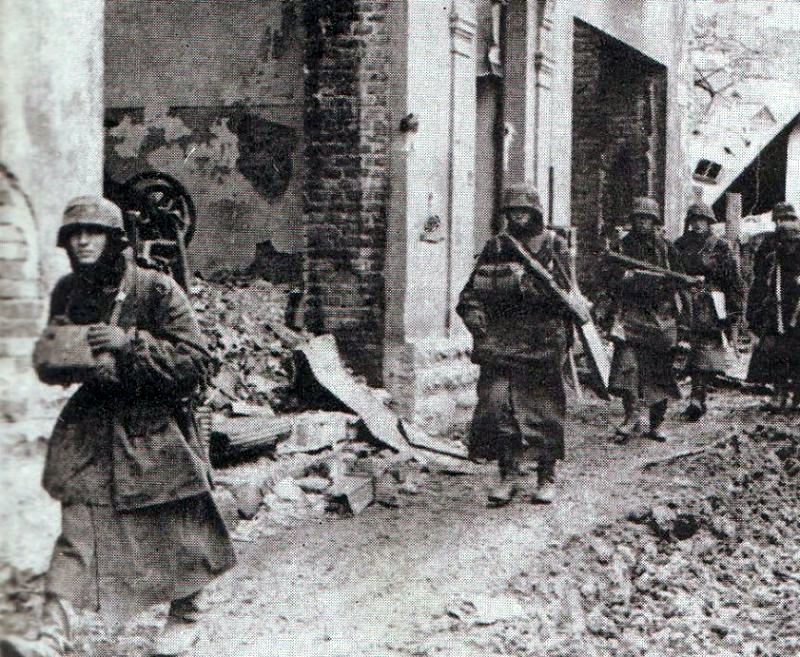
Preceding Events
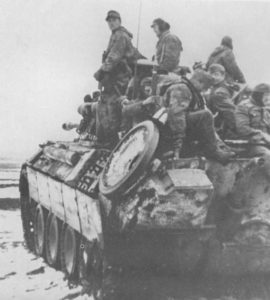
Prior to the encirclement, the German forces were engaged in a relentless defense against the Soviet Union’s advances post-invasion.
The Red Army had launched several offensives, substantially pushing back the Germans who were aiming to hold on to their captured territories.
The confrontation at Kamenets-Podolsky pocket evolved as a result of these series of military maneuvers on the Eastern Front, leading up to a significant clash that would influence subsequent military engagements in the region.
Forces and Commanders
In the Battle of Kamenets–Podolsky in 1944, the two opposing forces were led by a structured command hierarchy with notable commanders at the helm.
The Soviet forces aimed to encircle the German 1st Panzer Army, while the Axis command strategized to maintain a strong defensive front with its allies, including Hungarian forces.
Soviet Command Structure
The Red Army was under the overarching leadership of Joseph Stalin, who worked closely with his senior military commander, Georgi Zhukov.
During the battle, the main Soviet force was the 1st Ukrainian Front, which played a crucial role in encircling the German forces.
The command structure of the Soviet forces emphasized strategic deployment and coordination of large-scale offensives.
Axis Command Structure
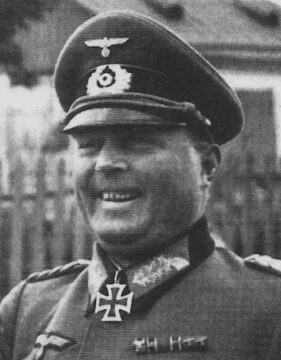
The Axis powers in this battle were primarily composed of the German Wehrmacht, which included the 1st Panzer Army and the 4th Panzer Army, with additional support from Hungarian soldiers.
The 1st Panzer Army was under the command of Generaloberst Hans-Valentin Hube, who answered to commanders higher up in the hierarchy, such as Erich von Manstein and later Walther Model, following von Manstein’s dismissal by Adolf Hitler.
The German strategy involved deploying the feared German Panther tank alongside Hungarian forces within the context of Army Group South Ukraine, facing off against the overwhelming Soviet presence.
Key Military Operations
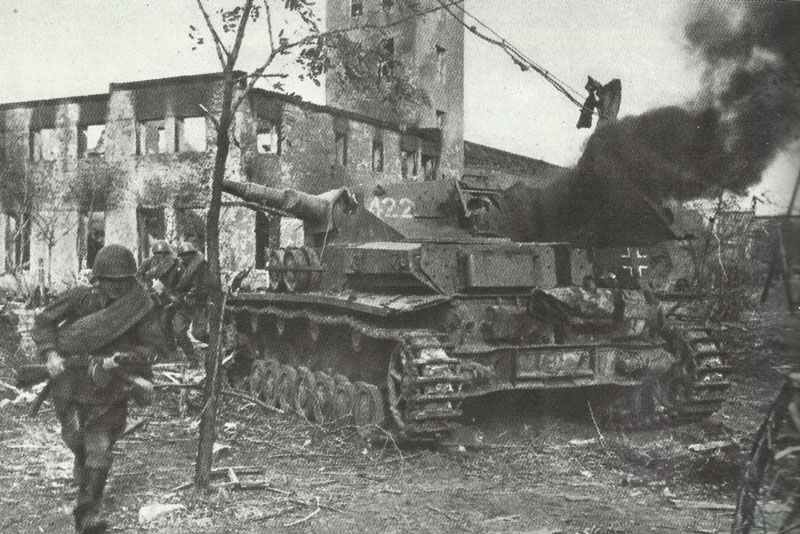
The Battle of Kamenets-Podolsky in 1944 featured pivotal military operations that shaped its outcome. These operations included strategic offensives by the Red Army, culminating in the creation of the Kamenets-Podolsky Pocket.
Proskurov–Chernovtsy Offensive
Launched in March 1944, the Proskurov–Chernovtsy Offensive formed a critical part of the Dnieper–Carpathian Offensive.
The Red Army focused on capturing key regions in the western Ukrainian SSR, pushing Axis forces westward and laying the groundwork for encircling German armies in the Kamenets-Podolsky area, later known as Hube’s Pocket.
Dnieper–Carpathian Offensive
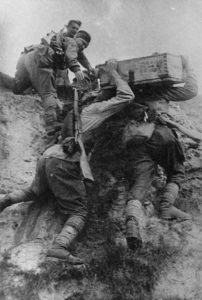
Initiating one of the most formidable offensives of the Eastern Front, the Dnieper–Carpathian Offensive led Soviet forces to reclaim lost territory and inflict considerable losses upon Axis forces.
Spearheaded by the Red Army, this strategic campaign spanned from December 1943 to April 1944 and was instrumental for securing a Soviet victory over the occupiers, fundamentally reversing the tide of war in the region.
Encirclement and Creation of the Kamenets-Podolsky Pocket
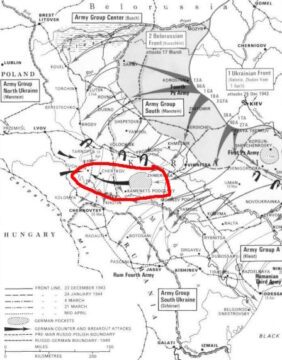
As a direct consequence of the Dnieper–Carpathian Offensive, German troops found themselves encircled, leading to the formation of the Kamenets-Podolsky Pocket.
The Red Army tightened its grip around the pocket in late March 1944, trapping a large number of Axis troops.
This began as successful maneuvering from Soviet forces, seeking to cut off and isolate enemy divisions, effectively weakening their presence and operational capability in Ukraine.
The Battle
The Battle of Kamenets–Podolsky was a significant engagement during World War II, where the Red Army encircled German forces in a pocket and achieved a strategic victory for the Soviet Union.
Initial Encounters
The Soviet Union’s aggressive offensive began shortly after the Korsun-Cherkassy Pocket, with the 1st Ukrainian Front initiating the Proskurov-Chernovtsy Operation.
They made rapid gains against German forces, comprising elements from the VII Army Corps and LVI Panzer Corps, who were caught by surprise due to the swift Soviet attack.
Tactical Engagements
German forces, including the 1st Army, found themselves in a precarious situation, engaged in a series of fierce battles to hold their positions.
The 1st Tank Army of the Soviets proved instrumental in the encirclement, dealing heavy blows to the German defenses.
Subsequently, tactical engagements intensified as both sides deployed armored and infantry divisions in an attempt to sway the battle.
On Friday, March 24, 1944, Hube’s 1st Panzer Army was surrounded by units of the 1st Ukrainian Front in the Kamenets–Podolsky area.
As virtually his last official act before he was ordered to the Führer’s headquarters and relieved by Hitler on March 30, 1944, Field Marshal von Manstein ordered the doomed 1st Panzer Army to break out. Manstein was replaced by Generalfedmarschall Model and Army Group South was renamed Army Group North Ukraine. On the same day, Soviet troops also occupied Chernivtsi, around 100 kilometers southwest of the trapped 1st Panzer Army.
Surprisingly for the Soviets, the 1st Panzer Army now attacked in a westerly direction, in the rear of their attack units that had rushed far ahead. In contrast, the Soviets had expected a breakout to the south, where the distance to the German front was much shorter.
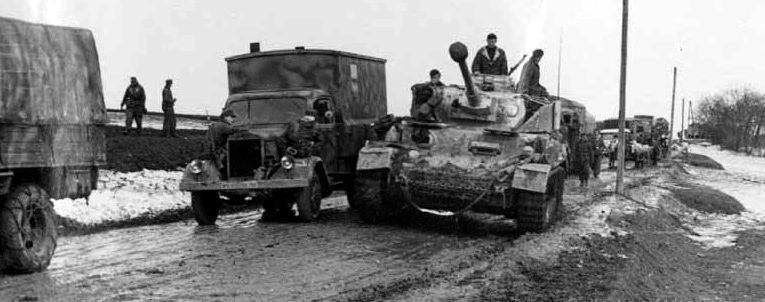
According to Manstein’s plan, Hube pushed through to the west with his tank army in a ‘wandering pocket’. Thanks to his proven leadership, the withdrawal movement was exemplary. There was no panic among the troops and no wounded were left behind.
They were supplied from the air, and 7,270 wounded were flown out.
When a fuel crisis did occur during the breakthrough, all other vehicles had to be destroyed except for the armored vehicles and the most important command vehicles.
The tactical order during the breakout organized by Hube was as follows: The armored divisions attacked in overlapping sorties to the west into the rear Soviet lines of communication and secured against the north.
The infantry divisions formed the rearguard and covered the retreat with stalling defensive battles.
To the south, where the Dniester River formed a barrier, only reconnaissance units were deployed.
All non-combatant units and the wounded and sick were located in the center of the wandering pocket.
Axis Counteroffensives
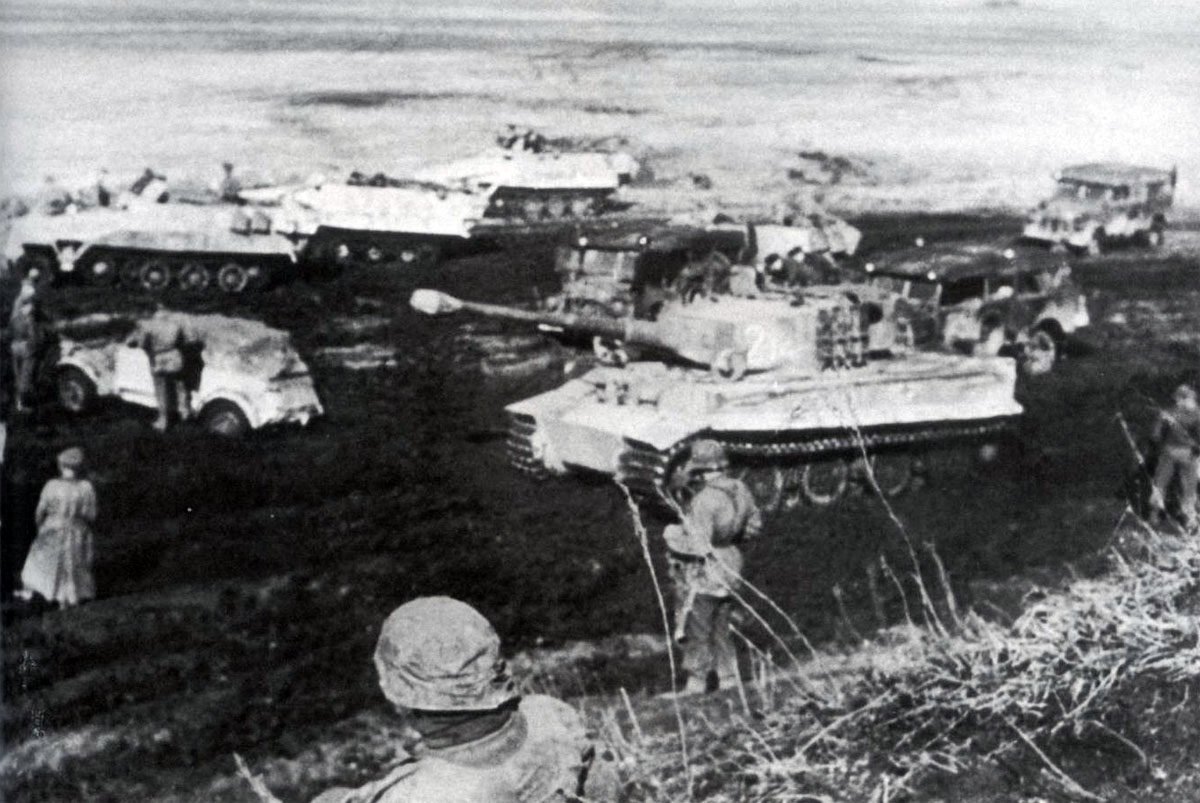
In an effort to break the encirclement, the 2nd SS Panzer Corps and additional units from the German Forces launched several counteroffensives.
Despite initial successes in creating narrow corridors to the trapped forces, sustained Soviet pressure and counterattacks made these efforts increasingly difficult, showcasing the tenacity of the defending troops.
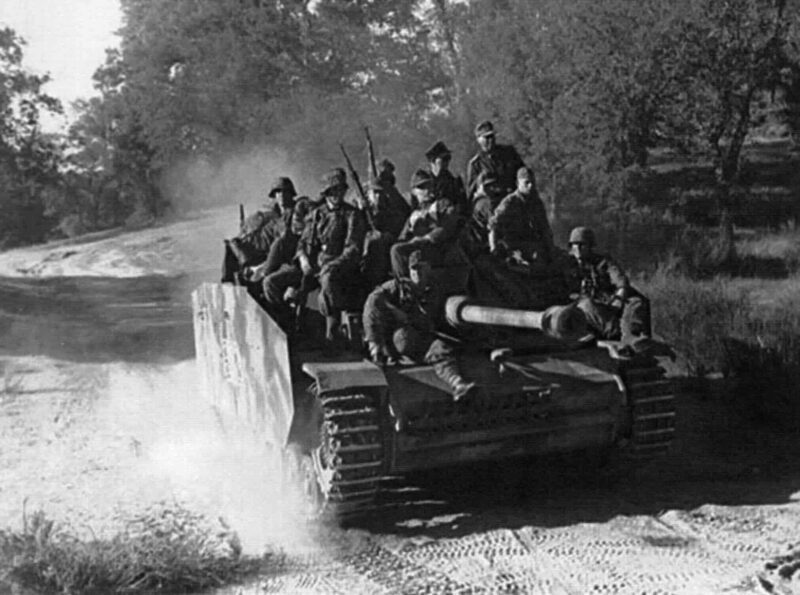
On April 7, 1944, the ‘wandering pocket’ of Hube finally met the advance units of Hausser’s 2nd SS Panzer Corps.
After a brief refresher, the mass of the 1st Panzer Army was quickly ready for action again and took over the front section in front of Lemberg, as many of the armored vehicles and artillery guns could be saved.
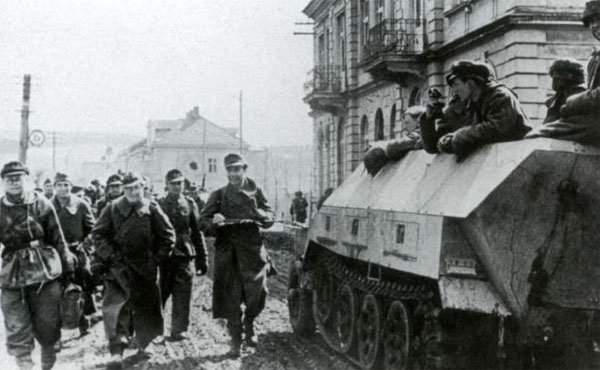
Losses
According to reports from the 1st Panzer Army, 352 Soviet tanks and assault guns and 280 artillery pieces were destroyed during the retreat in the ‘wandering pocket’.
48 German battle tanks and assault guns were lost during the breakout, as well as nearly all motor vehicles, which had to be destroyed due to lack of fuel. However, 50,000 horses maintained mobility.
German personnel losses amounted to 2311 killed, 3567 missing and 8364 wounded.
Aftermath and Strategic Impact
The Battle of Kamenets-Podolsky in 1944 culminated in a strategic Soviet victory, leading to significant ramifications for Axis forces, particularly in the liberation of Western Ukraine and shaping subsequent military operations. especially the great Soviet summer offensive of June 22, 1944.
Since then, the battle has been regarded as an operational example of how large armored formations can break out of a military encirclement and be rescued.
Expulsion of Axis Forces from Western Ukraine
The successful encirclement of the 1st Panzer Army resulted in the retreat and eventual expulsion of Axis powers from Western Ukraine.
This Soviet victory not only diminished the presence of Axis forces in the area but also paved the way for Soviet advances into territories that were previously under Axis control.
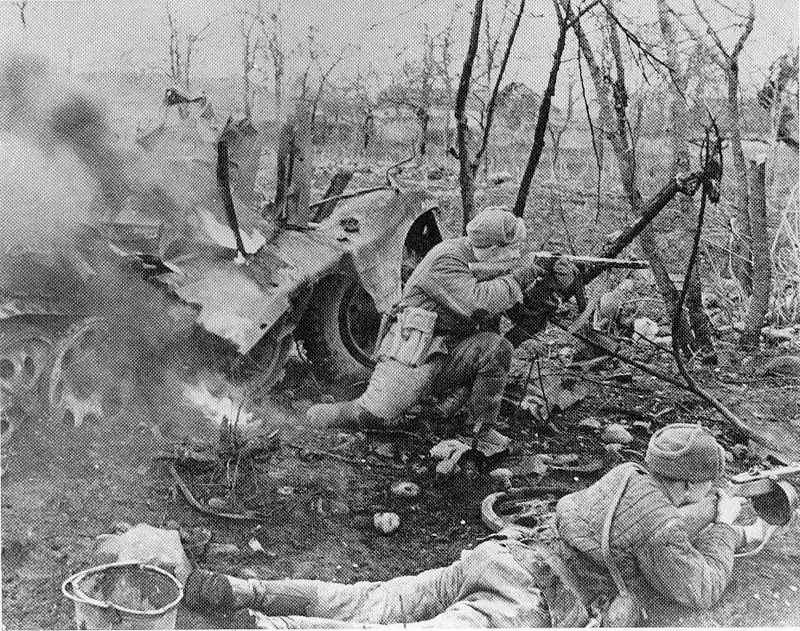
Impact on Subsequent Operations
Following the breakout from the Kamenets-Podolsky pocket, subsequent Soviet military efforts, such as Operation Bagration, were bolstered.
The removal of German troops from the Carpathian Mountains facilitated the Red Army’s subsequent offensives, culminating in rapid gains in the summer of 1944.
Additionally, the impact of the battle synchronized with the Allied D-Day Landings in Western Europe, putting the Axis on the defensive on both Eastern and Western fronts.
Holocaust and War Crimes
The Battle of Kamenets–Podolsky in 1944 cannot be discussed without acknowledging the horrific war crimes committed by the Nazis, including the systematic persecution and mass murder of Jews in Western Ukraine.
Holocaust atrocities in this region exemplify the ruthless implementation of the Final Solution.
Jewish Communities in Western Ukraine
In Western Ukraine, cities like Kolomyia were home to vibrant Jewish communities before World War II.
The German invasion brought untold suffering to these communities as they became prime targets for extermination as part of the Nazi’s genocidal policies.
Nazi Policies and Actions
The Holocaust represents the peak of Nazi crimes against humanity, which included enacting the Final Solution—the plan to annihilate the Jews of Europe.
In places like Kamenets-Podolsk, the Nazis executed their policies through organized massacres, often with the assistance of local collaborators.
The Role of Friedrich Jeckeln and the Einsatzgruppen
Friedrich Jeckeln and his Einsatzgruppen were key figures in the execution of the Holocaust in Ukraine.
Their methods included mass shootings and extreme brutality, resulting in the murder of thousands.
Historical records from the United States Holocaust Memorial Museum detail how Jeckeln played a direct role in these war crimes, systematically targeting Jewish populations.
Commemoration and Legacy
The Battle of Kamenets-Podolsky, fought during World War II, has been remembered for its tactical maneuvers and strategic outcomes.
The engagement, which took place in the city of Kamianets-Podilskyi, has become a subject of study for military historians, serving as a stark example of the complexities of warfare.
Monuments and Memorials
Monuments have been erected within Kamianets-Podilskyi to honor those who lost their lives. These memorials serve as poignant reminders of the past, ensuring that the events that transpired are never forgotten.
The presence of these commemorations infuses a sense of historical significance within the local community and among visitors.
Educational Efforts
- In academic circles, the battle is frequently analyzed for its military tactics and its impact on subsequent operations.
- Historical documentaries and publications often include detailed accounts of the skirmish as part of a broader examination of the Eastern Front.
Annual Commemorations
Every year, there are gatherings and ceremonies in the area to mark the anniversary of the battle. These events bring together veterans, historians, and members of the public, fostering a collective remembrance of the sacrifices made.
Through these channels of remembrance, the legacy of the Battle of Kamenets–Podolsky 1944 remains ingrained in public consciousness, providing valuable insights into the toll of war and the resilience of those involved.
The city of Kamianets-Podilskyi stands not only as a historical site but also as a testament to the enduring lessons of the conflict.
Frequently Asked Questions
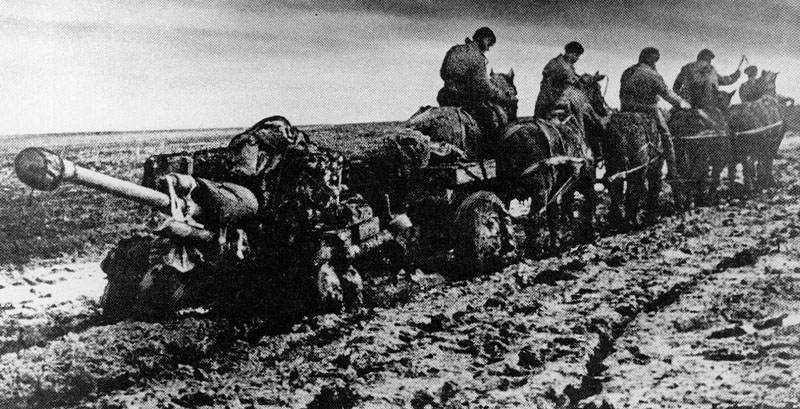
In this section, we address several key questions regarding the pivotal Battle of Kamenets–Podolsky in 1944, which was a significant confrontation on the Eastern Front of World War II.
What were the strategic objectives of both sides in the Battle of Kamenets–Podolsky?
The strategic objective for the Soviet forces was to encircle and destroy the 1st Panzer Army, thereby eliminating a substantial component of the German military strength on the Eastern Front.
Conversely, the Germans aimed to break the encirclement and withdraw their forces to a more defensible position.
How did the encirclement of German forces occur in the Battle of Kamenets–Podolsky?
The encirclement of German forces took place as a result of the Soviet Proskurov-Chernovtsy offensive. The rapid advance of the Soviet Army cut off the 1st Panzer Army from the rest of German Army Group South.
What role did the 1st Panzer Army play in the Battle of Kamenets–Podolsky?
The 1st Panzer Army, a key component of the German military, was tasked with holding the line against the Soviet advance. However, it found itself surrounded, which necessitated a planned withdrawal and fighting retreat to avoid complete destruction.
Which formations of the Soviet Army were involved in the Battle of Kamenets–Podolsky?
Multiple Soviet Army units were involved, with key contributions from the 1st Ukrainian and 2nd Ukrainian Fronts. These fronts executed the encircling maneuvers that led to the creation of the Kamenets-Podolsky pocket.
What were the outcomes and consequences of the Battle of Kamenets–Podolsky for the Eastern Front?
As a result of the battle, the Germans were able to successfully break out from the encirclement, though with some losses in troops and materiel.
For the Soviets, the battle was a missed opportunity to eliminate significant German forces on the eastern front.
How did the Battle of Kamenets–Podolsky influence subsequent World War II military operations?
The Battle of Kamenets–Podolsky set the stage for future Soviet offensives by demonstrating the effectiveness of encirclement tactics and deep operational maneuvers.
At the same time, military tacticians regard Hube’s ‘wandering pocket’ as a prime example of how a trapped large unit can be rescued and used to build a new front line.
References and literature
Krieg der Panzer (Piekalkiewicz)
Chronology of World War II (Christopher Argyle)
Der Grosse Atlas zum II. Weltkrieg (Peter Young)
Kriegstagebuch des Oberkommandos der Wehrmacht, Band 1-8 (Percy E. Schramm)
Das Deutsche Reich und der Zweite Weltkrieg (10 Bände, Zentrum für Militärgeschichte)
Der 2. Weltkrieg (C. Bertelsmann Verlag)
A World at Arms – A Global History of World War II (Gerhard L. Weinberg)







